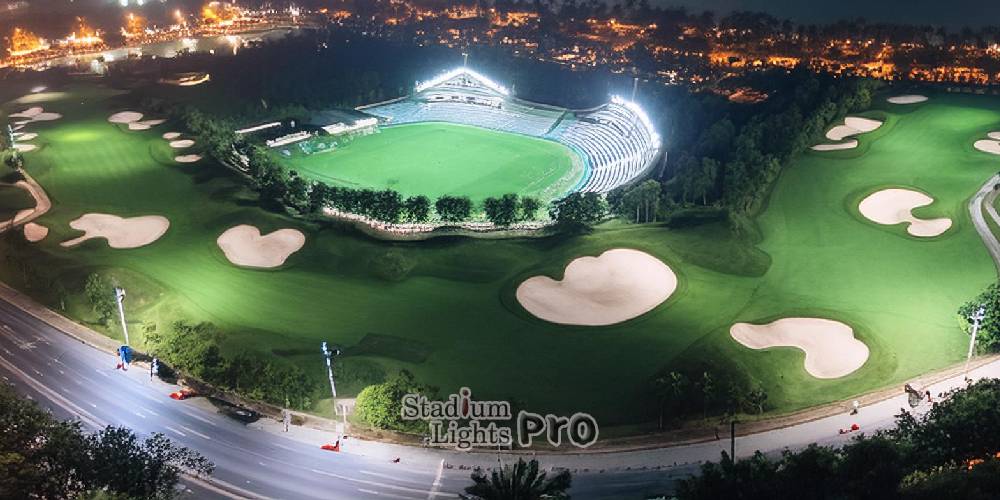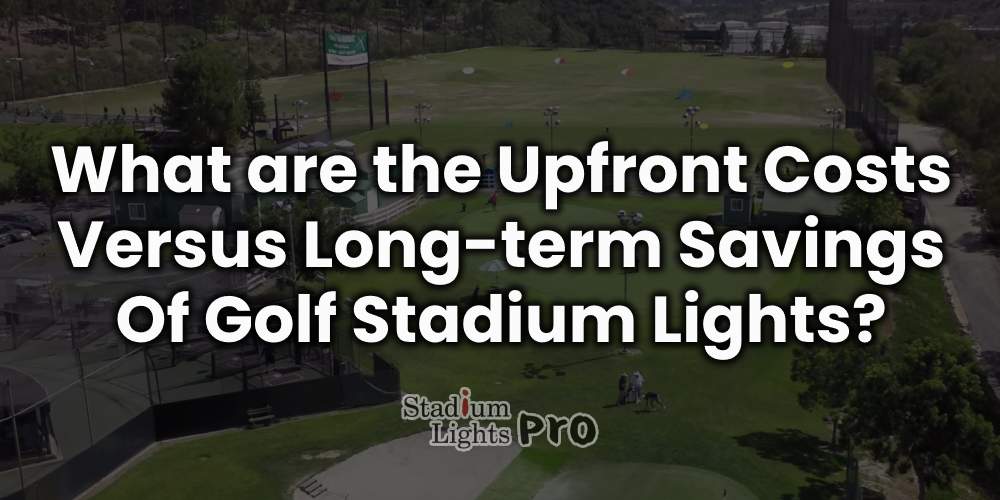As venues seek to enhance their facilities with efficient and effective lighting solutions, the focus has shifted towards energy-efficient options. These lighting systems not only illuminate the playing field but also offer significant benefits in terms of cost-effectiveness and sustainability. In this discussion, we explore the dynamics of upfront costs versus long-term savings associated with energy-efficient golf stadium lights.
Table of Contents
ToggleImportance of Considering Upfront Costs and Long-Term Savings
When embarking on the journey of upgrading or installing golf stadium lighting, it’s crucial to weigh the upfront costs against the potential long-term savings. While the initial investment may seem daunting, especially for energy-efficient solutions which often come with a higher price tag, the benefits over time can be substantial. By considering both the immediate expenses and the anticipated returns in terms of reduced energy consumption, maintenance savings, and environmental impact, stakeholders can make informed decisions that align with their financial and sustainability goals. Thus, understanding the balance between upfront costs and long-term savings is paramount in ensuring the economic and ecological viability of lighting investments in golf stadiums.
Upfront Costs of Energy-Efficient Golf Stadium Lights
Initial Purchase Cost
The initial purchase cost of energy-efficient lighting fixtures for golf stadiums varies widely. These fixtures come in a range of prices, depending on factors such as the type of technology, lumens output, and specific features. Prices can range from moderately affordable options to high-end, premium fixtures designed for maximum efficiency and performance. Several factors influence these upfront costs, including the brand, quality, and technology of the fixtures. Established brands may command higher prices due to reputation and quality assurance. Higher quality fixtures often come with a higher initial price but may offer better performance and durability, leading to long-term savings. Advanced technologies such as LED lighting may have higher upfront costs compared to traditional lighting solutions but offer significant energy savings over time.
Installation Expenses
Installing golf stadium lights requires professional expertise and specialized equipment, contributing to installation expenses. The cost of labor for installation can vary depending on factors such as the complexity of the project, accessibility of the site, and local labor rates. In addition to the lighting fixtures themselves, there may be additional equipment necessary for installation, such as mounting hardware, wiring, and control systems. These supplementary components can add to the overall upfront costs of implementing energy-efficient lighting solutions in golf stadiums.

Long-Term Savings of Energy-Efficient Golf Stadium Lights
Reduced Energy Consumption
Energy-efficient golf stadium lights offer substantial long-term savings through reduced energy consumption. When compared to traditional lighting solutions, energy-efficient lights typically consume less electricity while providing the same or better illumination levels. This comparison showcases the significant energy efficiency gains achieved with modern lighting technologies. Over time, these energy savings translate into tangible financial benefits for stadium operators, as they spend less on electricity bills.
Maintenance and Operational Savings
Reduced Need for Frequent Replacements: Energy-efficient lighting fixtures often have longer lifespans compared to traditional lights. This means that they require fewer replacements over time, reducing the associated labor and material costs. Stadium operators can benefit from reduced downtime and operational disruptions, resulting in increased productivity and revenue generation.
Lower Maintenance Costs Due to Longer Lifespan
The longer lifespan of energy-efficient golf stadium lights not only reduces the frequency of replacements but also lowers maintenance costs. With fewer instances of bulb changes and maintenance interventions, stadium staff can allocate resources more efficiently and focus on other operational priorities. Additionally, the durability of energy-efficient fixtures contributes to fewer repairs, further minimizing maintenance expenses.
Environmental Benefits
Reduction in Carbon Footprint: Energy-efficient lighting solutions contribute to environmental sustainability by reducing carbon emissions. By consuming less electricity, these lights help decrease the overall carbon footprint associated with operating golf stadiums. This environmental benefit aligns with global efforts to mitigate climate change and promote sustainable practices in various industries.
Compliance with Energy Efficiency Regulations
Investing in energy-efficient golf stadium lights ensures compliance with energy efficiency regulations and standards. Many jurisdictions have implemented regulations aimed at reducing energy consumption and promoting the adoption of eco-friendly technologies. By choosing energy-efficient lighting solutions, stadium operators demonstrate their commitment to environmental responsibility while avoiding potential penalties or fines associated with non-compliance.
Case Studies or Examples
Real-world Examples of Organizations or Venues Benefiting from Energy-efficient Lighting
Several organizations and venues have realized significant benefits from adopting energy-efficient lighting solutions for their golf stadiums. For example, the PGA Tour’s TPC Sawgrass in Florida implemented LED lighting for their stadium, resulting in reduced energy consumption and enhanced visibility for players and spectators. The installation not only improved the quality of lighting but also generated cost savings through lower electricity bills and decreased maintenance expenses.
Similarly, the Royal & Ancient Golf Club of St Andrews in Scotland upgraded their stadium lighting to energy-efficient LED fixtures. This transition not only improved the overall illumination of the course but also aligned with the club’s commitment to sustainability and environmental stewardship. The reduced energy consumption and maintenance requirements resulted in long-term savings while minimizing the club’s ecological footprint.
Cost Savings Analysis Based on Specific Scenarios or Installations
| Aspect | Cost Range |
|---|---|
| Stadium Construction | $50,000,000 – $150,000,000 |
| Golf Course Design | $500,000 – $1,500,000 |
| Clubhouse Construction | $5,000,000 – $20,000,000 |
| Maintenance Equipment | $100,000 – $500,000 |
| Irrigation System Installation | $500,000 – $1,000,000 |
| Parking Facilities | $1,000,000 – $5,000,000 |
| Scoreboard and Signage | $100,000 – $500,000 |
| Lighting System | $1,000,000 – $5,000,000 |
| Landscaping and Greenery | $500,000 – $2,000,000 |
| Security Systems | $200,000 – $1,000,000 |
In a comparative cost analysis, a golf stadium considering the transition from traditional metal halide lighting to energy-efficient LED fixtures conducted a thorough evaluation of upfront costs and long-term savings. The analysis factored in the initial purchase cost of the LED fixtures, installation expenses, and projected energy savings over a specified period.
Based on the analysis, it was determined that while the upfront investment for LED lighting was higher compared to traditional fixtures, the potential energy savings over the lifespan of the LEDs outweighed the initial costs. Additionally, the longer lifespan and reduced maintenance requirements of LED fixtures contributed to additional cost savings over time. By quantifying the financial benefits of transitioning to energy-efficient lighting, the stadium management made an informed decision that not only improved the quality of illumination but also optimized operational efficiency and reduced long-term expenditures.

Factors Influencing Cost and Savings
Location-Specific Factors
Location-specific factors play a crucial role in determining the overall cost and savings associated with energy-efficient golf stadium lighting. Variables such as electricity rates, which can vary significantly from one region to another, directly impact the operational expenses of the lighting system. Higher electricity rates necessitate greater emphasis on energy efficiency to achieve substantial savings over time. Conversely, regions with lower electricity rates may prioritize other factors in their decision-making process.
Furthermore, incentives and rebates offered by local governments or utility companies can influence the financial feasibility of energy-efficient upgrades. These incentives often aim to encourage the adoption of sustainable technologies by providing financial assistance or tax breaks to offset the initial investment. Stadium operators must consider such incentives when evaluating the cost-effectiveness of transitioning to energy-efficient lighting solutions.
Technology Advancements and Future Cost Projections
The landscape of lighting technology is continually evolving, with advancements leading to improved energy efficiency, performance, and affordability. As newer technologies emerge, the cost of energy-efficient lighting solutions may decrease over time, making them more accessible to a broader range of stakeholders. Additionally, ongoing research and development efforts contribute to the refinement of existing technologies, enhancing their efficacy and longevity.
However, it’s essential to consider future cost projections when assessing the long-term savings of energy-efficient lighting. While upfront costs may decrease with technological advancements, the potential for energy savings and maintenance efficiencies must also be factored into the equation. Stadium operators should stay informed about industry trends and forecasts to make informed decisions regarding the timing of lighting upgrades and investments.
Consideration of Financing Options or Incentives for Energy-Efficient Upgrades
Financing options and incentives can significantly mitigate the financial burden of transitioning to energy-efficient golf stadium lighting. Stadium operators may explore various financing mechanisms, such as leasing arrangements or energy performance contracts, to spread out the upfront costs over time. These financing options allow organizations to implement energy-efficient upgrades without a substantial initial capital outlay, thereby improving cash flow and budgetary flexibility.
Additionally, incentives provided by government agencies, utility companies, or industry organizations can further offset the cost of energy-efficient upgrades. These incentives may include grants, rebates, or low-interest loans designed to promote sustainability and environmental conservation initiatives. By leveraging available financing options and incentives, stadium operators can maximize cost savings while minimizing the financial barriers associated with transitioning to energy-efficient lighting solutions.
Conclusion
The decision to invest in energy-efficient golf stadium lights requires careful consideration of both upfront costs and long-term savings. While the initial investment may seem daunting, particularly for energy-efficient solutions with higher upfront costs, the potential for significant long-term savings cannot be overlooked. By weighing the immediate expenses against the anticipated returns in terms of reduced energy consumption, maintenance efficiencies, and environmental benefits, stakeholders can make informed decisions that align with their financial and sustainability objectives.

